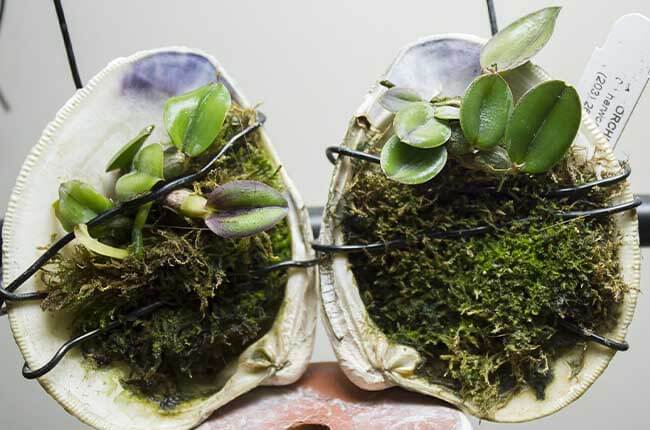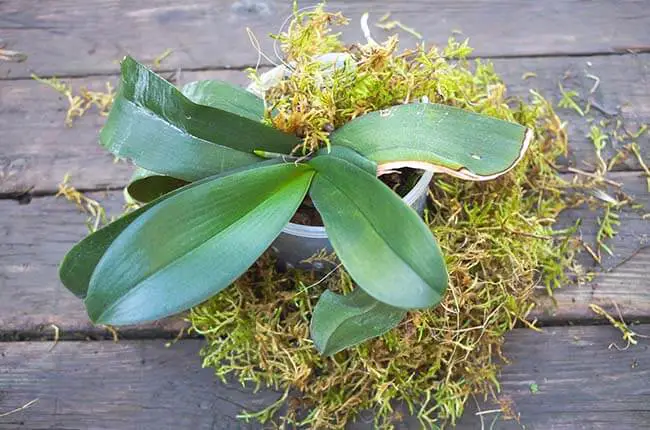When you run out of sphagnum moss for potting or mounting your orchids, you may be wondering about the green live moss outside in nature. Plus, that would make the orchid look quite nice, wouldn’t it?
What about using live moss instead of dried moss as growing medium?
Live moss can be used in top dressing orchids for decoration. It’s beneficial for mounted orchids to retain moisture around the roots for long periods. But, it’s not recommended for wrapping around the roots of potted orchids, especially for beginners due to the risk of root rotting, introducing pests and contracting fungal disease.
Before you head out to remove those green moss from the outside, check out the pros and cons in this article to help you decide.
Benefits with live moss as growing medium
More and more orchid lovers are switching from using dried sphagnum moss to using live green moss to pot or mount their orchids. There are several reasons why many turn to live moss:
1. It is cheap, or practically free
If you have live moss in your lawn or your property, harvesting live moss is free (Note: it can be illegal to harvest moss from parks and forests, depending on your country rules). On the other hand, buying dried moss from the store can be expensive, especially if you have to repot at least 20 orchids every year.
2. It makes the pot look more natural and beautiful
Having a live, green fluffy moss in your orchids is like bringing a piece of the forest to your room. It is more aesthetically pleasing than the dried brown moss, which tends to flatten over time.
3. Live moss has longer shelf life, saving the work of remounting it every year
If you use live moss to mount your orchids, the moss would continue to grow and stay around the roots. On the other hand, dried moss would decompose and you would need to remount the orchid every now and then. Not only is it extra work for the gardener every year, it also puts stress on your orchid.

Problems with live moss as growing media
Despite the benefits of using live moss, it is generally not recommended because of a few potential problems:
1. Live moss may introduce pests
The constantly wet moss is a perfect habitat for many insects, such as ants, spiders, mites, worms, etc. They like to lay eggs there or live in or under the moss. Live moss is also full of dirt and debris which can be hard to clean.
2. Live moss retains too much water for orchids
Live sphagnum moss requires an environment that is constantly wet or very wet. It can soak up and retain more than 8 times its own weight in water for a long period and slowly releases it.
Too much moisture around the orchid roots and stem for long periods, however, may cause root rot and stem rot.
Orchids need to have their roots dried between watering. The ideal environment for orchid roots is moist but also well-ventilated or not water-bogged. So, for those in humid environments, live moss is definitely not suitable for wrapping around the roots or stem of potted orchids.
3. Live moss die easily without enough humidity
Live sphagnum moss requires an environment that is constantly wet or very wet to survive.
When they are under the direct sun in the summer, the heads or the tips of the moss would dry off, go brown and die. The orchid, however, requires more sunlight than the moss. So, it can be difficult to balance the sun and moisture needs of the orchid and the moss.
Also, live moss may die if the fertilizer for the orchid is too strong.
It can also die when watered using tap water which contains too much chlorine. If the moss dies, it would decompose into peat which can easily get moldy and attract pests for the orchid.
4. Live moss can transmit fungal disease to humans
According to the Centers for Disease Control and Prevention, sphagnum moss can cause a disease called Silicosis or Sporotrichosis. Spores of the moss carry a fungus called Sporotrichum schenckii, which can enter the body through inhalation or small scratches or wounds in the skin to cause bumps and ulcer on the skin.
Other areas may also be infected as the fungus spreads through lymph vessels. If untreated In some cases, the fungus could slowly progress to the bones and attack other parts of the body. Live sphagnum must be handled carefully with a facial mask and gloves.
What type of live moss can you use with orchids?
Nevertheless, some people have successfully used live moss to grow their orchids. A crucial factor for success is the type of moss.
According to Britanica, there are 12,000 moss species around the world. But you would have higher success using Sphagnum moss with orchids. Sphagnum moss has fluffy, long spindly stems. It does not easily break down and does not have a thick base so that wrapping the moss around the roots would not suffocate the orchid and allows air to go into the roots.
Sphagnum is a genus of 380 species of mosses. On the Pacific Northwest coast, for example, there are about 40 species.
Where can I find live Sphagnum moss?
Sphagnum moss can be found growing on bogs, swamps wet, and shady places near rivers, springs, and lakes, although they can also be found in open, sunny places.
Its characteristics are:
- growing in small patches or thick, dense clumps
- with very shallow roots
- usually light green-colored, but some species have yellow, pink, deep red, brown leaves
Instead of collecting live moss from the wild, you may be wondering if you could revive the dried moss you bought from the store. The short answer is: nope, you cannot.
Is it legal to harvest moss from the wild?
It is illegal to harvest moss in many countries such as the USA, the UK. In the UK, the common Sphagnum balticum (Baltic Bog-moss) is protected species. If the moss is growing within your private property, you can harvest it.
If you want to grow live moss, it is recommended that you purchase a small quantity of live sphagnum moss online and multiply them in your greenhouse.
How can I use live moss with my orchid?
To prevent the green moss from bringing pests to your orchid, you need to:
- Wash the moss in water to remove any rocks, grass, seeds, dirt and debris.
- Sterilize the moss by soaking it in hydrogen peroxide overnight to kill possible pests, snails in the moss.
- Once the moss is clean, you can use the green moss just like the dried ones to wrap around the roots, and/or put it on top as dressing.
- Remember to handle live moss with gloves and a facial mask because of the risk of contracting fungal disease.
Is Reindeer moss good for orchids?
You may also be wondering about Reindeer moss and Spanish moss, etc. because you often see them in the floral moss section of your local Home Depot or on Amazon.
They are a fantastic addition to just top-dress your orchids for decoration, and would not hurt your orchid.
Most of the floral moss sold is “preserved“, meaning they are not alive and are dyed to have a green color. When you water your orchid, just remove the moss plant and put them back afterward.
As a potting medium, reindeer moss is not a good choice for orchids because it is too acidic and does not hold much water. When it breaks down into pieces, it does so quickly and would not let enough air into the roots. Sphagnum moss is still the best moss type for wrapping around the orchid roots.
Conclusion
To sum up, it is not the best idea to use live moss especially for wrapping around the roots of potted orchids. This is because it may introduce pests; it can retain too much water for the orchid and risk root rotting; it is also difficult to keep the live moss alive and may pass fungal disease to humans.
But, for top-dressing potted orchids or mounted orchids, live moss is not likely to damage your orchid and would even add a natural look.
Happy gardening!
Sources
Disadvantages of Growing Plants in Sphagnum Moss
What is Silicosis or Sporotrichosis?
Related
Top 18 Mosses for Indoor Plants & Living Wall
Can you reuse sphagnum moss for orchids? (Explained)
Can Dried Sphagnum Moss Return To Life?
- Keiki Paste vs Rooting Hormone:What’s the difference? - February 4, 2024
- Top 10 Orchid Fertilizers: A Comprehensive Review (2024) - February 2, 2024
- Top 8 Soil Inoculants For Stronger Plants (2024) - February 1, 2024




